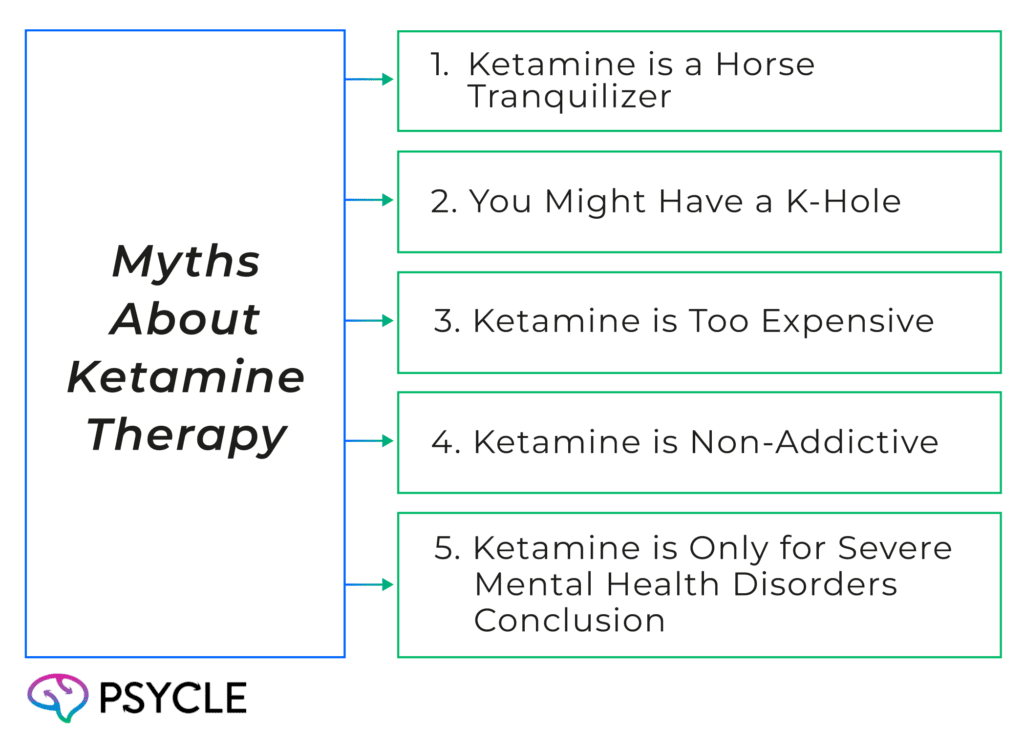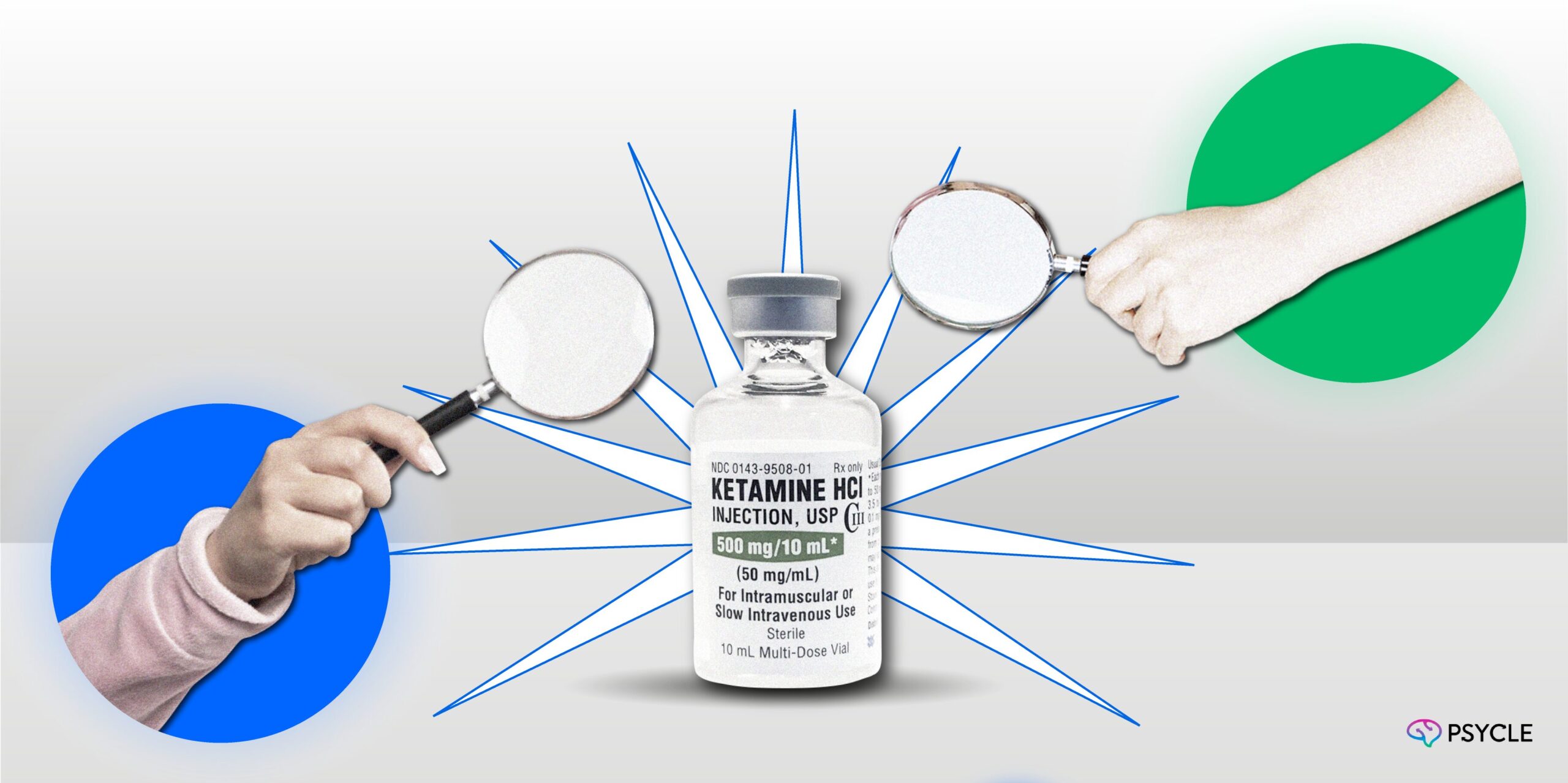Ketamine therapy is proving to be a powerful therapy option in mental health, but misconceptions about the drug often hold people back from exploring its benefits. At the same time, some claims from providers might also downplay the risks of ketamine, leaving people unprepared for potential caveats to the therapy.
In this article, we’ll dispel the most common myths about ketamine therapy to help you make informed decisions about whether this therapy could be right for you.

Key Takeaways
- Despite its reputation as a “horse tranquilizer,” ketamine was originally developed for human medical use and has significant therapeutic applications in treating mental health issues, chronic pain, and more.
- Risks like “K-holes” or addiction are largely mitigated in clinical contexts, where doses are carefully controlled and tailored, unlike in recreational use.
- While potentially costly, there are accessible options for ketamine therapy, including insurance coverage, flexible payment plans, and lower-cost telehealth services.
Myth One: Ketamine is a Horse Tranquilizer
While ketamine is used in veterinary medicine, the drug was initially developed as a human anesthetic in the 1960s. Scientists at Parke Davis Laboratories created ketamine as an alternative to phencyclidine (PCP), a widely used anesthetic at the time. PCP has medically valuable anesthetic properties but was of concern because it caused severe delirium in patients. Ketamine offered a safer and more reliable option.
After its development, ketamine became a go-to anesthetic for surgeries and was widely used to treat injuries during the Vietnam War. Around the same time, it also found a role in veterinary medicine for surgical operations in both small and large animals, including. Ketamine has since shown usefulness in a wide range of human clinical problems, including depression, anxiety, chronic pain, addiction, and more. However, its reputation for being a “horse tranquilizer” seems to have stuck.
Myth Two: You Might Have a K-Hole
A “K-hole” refers to an intense dissociative experience caused by high doses of ketamine, often associated with recreational use. It’s a phenomenon where users may feel disconnected from their body and normal sense of reality. Though some users actively seek these experiences, K-holes can be frightening and disorientating, putting many people off using ketamine.
However, in therapeutic settings, ketamine doses are significantly lower than those used in recreational settings and so are unlikely to cause K-holes. The focus of ketamine therapy is to achieve a mild dissociative state that can help patients process emotions and trauma—not sending them into an out-of-body spiral.
Some ketamine companies, such as the telehealth provider Joyous, provide ketamine in very small doses, unlikely to have any psychoactive effects. These providers focus more on ketamine’s neurological impact rather than any instant psychological effects.
For context, K-holes happen at doses of around 150mg, according to bdp. However, in therapy, intravenous ketamine is administered at an average dose of 0.5mg/kg, which works out to be 35mg for an average body weight of 70kg.
Myth Three: Ketamine is Too Expensive
Yes, ketamine therapy can have high upfront costs, especially for a full course of infusions. But there are ways to make it more accessible.
Certain clinics, like Emerge Ketamine, based in Massachusetts, provide superbills patients can submit to insurance providers to reduce the financial burden. Clinics might also accept Health Savings Accounts (HSAs) or Flexible Spending Accounts (FSAs), allowing patients to use pre-tax dollars for treatment. Additionally, flexible payment plans may be offered to spread the cost of therapy over time, making it more manageable for patients.
For those looking for even more affordable options, telehealth services like Joyous and Better U offer lower-cost alternatives. They utilize cheaper oral and nasal spray forms of ketamine and don’t require clinic costs since evaluations are done online. However, these cheaper options compromise the face-to-face support and safety guarantees offered by in-person clinics.
Spravato, a ketamine-based nasal spray approved by the FDA, is a financially accessible option for ketamine therapy. The treatment is covered by most major insurance companies, meaning insured patients may only need to cover co-pays, such as medical evaluations, making it very cheap. However, only patients with treatment-resistant depression (TRD) or major depressive disorder with suicidality (MDSI) may qualify for Spravato.
While it’s not cheap, the costs shouldn’t automatically deter you. Exploring financial options with providers of interest can help make the therapy more attainable.
Myth Four: Ketamine is Non-Addictive
This one needs a bit of nuance. Ketamine is indeed an addictive substance when used recreationally or without proper oversight. Long-term abuse can lead to severe health risks, including bladder issues and cognitive impairments.
That said, ketamine therapy in clinical settings is highly controlled, with doses tailored to the patient and strict monitoring. Addiction is unlikely in these circumstances. However, some people, particularly those with a history of substance abuse, might develop cravings for the drug after completing therapy.
If this concern resonates with you, be sure to discuss it with any potential providers. They can help you navigate the risks and implement safeguards, such as incorporating additional support systems or offering alternative treatments.
Myth Five: Ketamine is Only for Severe Mental Health Disorders Conclusion
Ketamine can have powerful benefits for people who have previously been non-responsive to conventional treatments, such as TRD and refractory anxiety disorders. However, the benefits of ketamine don’t stop there. Ketamine can support personal growth and emotional healing, regardless of someone’s psychiatric background.
Emerging research shows ketamine can be a powerful tool in psychotherapy, helping people gain new perspectives to deepen their self-awareness and break through emotional blocks. This makes it a tool not just for addressing mental health disorders but also for enhancing overall well-being.
Moreover, more people are reporting using ketamine for enhancing creativity, similar to classical psychedelics like LSD and magic mushrooms. Ketamine increases functional connectivity, the capacity for new neural connections to form in the brain, which can increase the ability to generate new ideas or ways of thinking.
Conclusion
Ketamine therapy is a promising yet often misunderstood treatment that offers hope for individuals struggling with mental health challenges, as well as those seeking personal growth. Through addressing common myths, we can see that ketamine therapy is far more nuanced and accessible than it might initially seem.
However, by doing your research and having open and in-depth communication with potential providers, you can determine if it’s the right treatment path for you.

